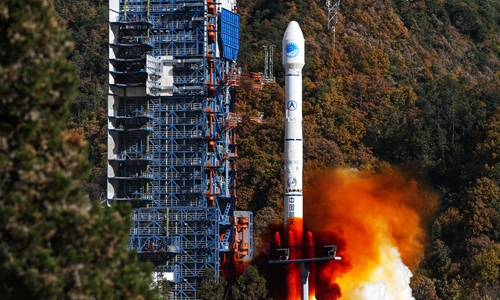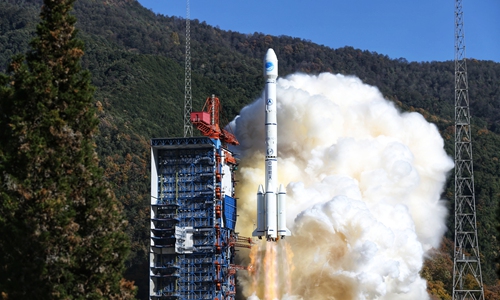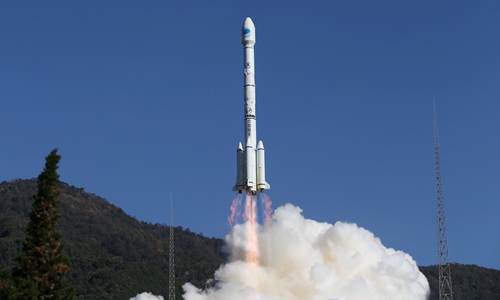China successfully sent the 52nd and 53rd satellites of its domestically developed BeiDou Navigation Satellite System (BDS) into space on Monday.
The pair are the last two medium Earth orbit (MEO) satellites of their kind for the BDS-3 constellation, marking the completion of the global navigation system's core constellation deployment, according to officials on Monday.
Launched from Xichang Satellite Launch Center, Southwest China's Sichuan Province, on board a Long March-3B carrier rocket with a Yuanzheng-1 (Expedition-1) upper stage, the two satellites were injected into designated orbits after more than three hours' flight.
It marks the completion of the BDS satellite launch campaign for this year, as well as the successful launch of all 24 BDS-3 MEO satellites, Yang Changfeng, chief architect of the BeiDou Navigation Satellite System, told the Global Times.
Since the first BDS-3 satellite was launched on November 5, 2017, China has conducted 18 BDS satellite launch missions, successfully sending 30 into their planned orbit and setting a national record for highest mission frequency and success rate, Yang said.
In-orbit tests will be carried out before the two MEO satellites are commissioned and by then the core constellation for the Chinese global navigation satellite system will be successfully completed, Yang said.

A Long March-3B carrier rocket with a Yuanzheng-1 upper stage takes off Monday afternoon from Xichang Satellite Launch Center, Southwest China's Sichuan Province, carrying the 52nd and 53rd satellites for the BeiDou Navigation Satellite System, or BDS. Photo: Cui Meng/GT
Wang Ping, chief designer of the BDS-3 system, said that the hybrid constellation design, in which three groups of satellites - the Inclined Geo Synchronous Orbit (IGSO), MEO and geosynchronous Earth orbit (GEO) - work in concert from different orbital regimes, was an exclusive BDS innovation and a world first.
Existing global navigation satellite systems such as the US Global Positioning System (GPS) and Russia's GLONASS (GLObal NAvigation Satellite System) only have a MEO satellite constellation, said Wang.
The MEO satellites, which are in orbit 20,000 kilometers above Earth, are a special type of satellite in charge of providing global service, whereas the IGSO and GEO satellites, which are in an orbit 360,000 kilometers above Earth, are mainly used to enhance regional service qualities, according to Wang.
That explained why completion of the MEO constellation was significant and marked the completion of the core network for BDS-3, he said.
In December 2018, the BDS-3 preliminary system was declared operational, with service provided by 18 in-orbit BDS MEO satellites and 16 in-orbit BDS-2 satellites. The complete BDS-3 MEO constellation consists of 24 MEO satellites evenly distributed in three orbit planes, Wang said.

Photo:Cui Meng/GT
After the Monday launch, with a full set of operational BDS-3 MEO satellites, BDS will have improved position dilution of precision (PDOP) value, meaning a seamless, stable BDS-3 global coverage without weak points has been implemented, Wang told the Global Times.
"We promise to deliver high-precision navigation and positioning services anywhere around the globe at any time," Wang said.
According to the chief architect, BDS-3 will have two more GEO satellite launches by June next year, to complete the deployment all 30 satellites of the BDS-3 constellation.
Feedback shows that the BDS service quality was already comparable to GPS since the end of 2018, and after completing BDS-3, "we will be as good as any GNSS (global navigation satellite system) in the world," Wang said.
China's BDS is among a few navigation systems that are available to provide short message communication services.
Although the traditional dominance of GPS is hard to shake on a global scale, BDS could challenge its market dominance and even surpass GPS in the Asia-Pacific region, Zhang Chi, an expert in telecommunications and a science author, told the Global Times.
The Chinese system has better precision with more satellites above the region, Zhang said.
Wu Di, a scholar with the satellite positioning technology center of Wuhan University in Central China's Hubei Province, said that hopefully BDS could replace GPS in countries and regions along the Belt and Road Initiative route, as the application of GPS there still remained at a basic level.
Wu pointed out that the BDS application still lags behind GPS in terms of user terminals and software.
A complete ecological chain for the BDS application has yet to be established, he noted.

Photo:Cui Meng/GT
World BDS
As BDS takes on a more important role in the field of satellite navigation, substantial progress has been achieved in cooperation and exchanges with other navigation satellite systems.
China and Russia have already entered a formal cooperation agreement. Signal compatibility and interoperability between BDS and GPS, and frequency coordination between China and Europe have made advances.
China's system has contributed to the development of global navigation satellite systems.
If all systems can operate correctly from design, through applications, equipment manufacturing and other aspects, "then we can provide better services for human beings," said David A Turner, deputy director of the office of space and advanced technology at the US State Department, speaking on the sidelines of the UN 14th Meeting of the International Committee on Global Navigation Satellite Systems in India earlier this month.
China has promoted BDS at GNSS standardization work of international organizations including the International Civil Aviation Organization, International Marine Organization and International Cospas-Sarsat Programme, a satellite-aided search and rescue initiative.
Before 2035, China will complete building a global positioning, navigation and timing system with BDS at its core, Yang said.
He stressed the principle of "China's BDS, the world's BDS and the world's top-class BDS," to serve the world and benefit mankind with better services and stronger capabilities.
Monday's launch marked the 12th completed by a Long March-3A rocket series rocket in 2019 as the rockets have achieved a 100 percent success rate in all missions.
The Long March-3A rocket series refers to Long March-3A, Long March-3B and Long March-3C. The rocket can carry a payload of 5.5 tons into geosynchronous orbit.
Since October 17, the series racked up five launches in 70 days, according to Beijing rocket developer the China Academy of Launch Vehicle Technology at the China Aerospace Science and Technology Corporation.


